
The Japanese quince is Finland’s lemon
Known as the lemon of the North, Japanese quince is ideal for making jam or marmalade.
When the Japanese quince (Chaenomeles japonica) blooms in late May, it catches the eye with its exotic look. This small, low-growing shrub can be completely covered in orange-red blossoms.
From September to October, the plant’s bright yellow, bumpy fruit offer more visual appeal. They have a pleasant citrus fragrance. Because the fruits don’t always fully ripen each autumn, they have not been widely used. The plant is mostly considered an ornamental shrub.
However, with new varieties that ripen as early as September, Japanese quince is becoming a genuine fruit crop. Its fruit can be turned into refined delicacies.
A dense-growing shrub
Japanese quince is a thorny shrub that grows to about half a meter, or at most one meter, in height. It produces many root shoots, so as it matures, it forms a dense stand.
In Finland’s southernmost regions, the frost-sensitive Chinese quince (C. speciosa) and hybrids of Japanese and Chinese quince called ornamental garden quince (C. x superba) also do well.
Japanese quince should not be confused with the quince (Cydonia oblonga), which is currently the only species in its genus. Ornamental quinces used to be classified in the Cydonia genus. The quince does not thrive in Finland, but in Central Europe it grows into a large, showy tree.
Japanese quince belongs to the rose family, like apples, pears, and rowan. Their kinship is so close that Japanese quince can be grafted onto a rowan trunk.
It does fairly well in Hardiness Zones I–II (III), though branches above snow level may freeze or be eaten by hungry rabbits. The ‘Cido’ variety can even make it in Zone IV.
How to get a harvest
It’s a good idea to plant groups of at least three Japanese quince shrubs to fully showcase their impressive spring bloom.
Because these plants are cross-pollinated, you’ll need at least two shrubs of different origins to ensure pollination. When buying young plants, be sure to ask how they were propagated.
Most commercially sold seedlings are grown from seed, so they typically have sufficient genetic variation. Therefore, pollination usually isn’t an issue. If you buy different varieties, you can be sure their genetics differ.
If your garden has Japanese quince shrubs that don’t produce fruit, they might share the same genetic background—for instance, if they were propagated vegetatively from summer cuttings. In that case, it’s a good idea to add a few more shrubs from another source to introduce new genetic material.

Plant Japanese quince in a warm, sunny spot. The shrub isn’t picky about soil quality, as long as water doesn’t collect around its roots.

The ripe fruit will be yellow and firm. Harvest them before the first frosts and let them keep ripening indoors.
The bumpy, ripe fruits look like lemons and have a pleasant lemon-like fragrance, which is where the plant gets its nickname. Once ripe, the flesh is hard and dense, so the fruits aren’t suitable for fresh use. However, their acidity and sharp flavor disappear after cooking, letting their aroma shine. They’re also high in pectin, making them great for jellies, jams, and marmalades.
Cut the fruits in half and remove the seeds, which contain harmful substances. These hard fruits soften quickly once cooked. You can also add vitamin C–rich Japanese quince to apples when making juices and jams.
Warmth and well-draining soil
Japanese quince does best in conditions similar to apple trees. However, since it’s somewhat tender, it needs a warm, sunny spot for the fruits to fully ripen. You can plant shrubs on a raised bed to speed up spring growth and, consequently, the harvest.
Japanese Quince not picky about soil quality, as long as water doesn’t gather around its roots.
Well-draining, nutrient-rich sandy, loamy, or sandy clay soil works best. A bit of lime is recommended for Japanese quince, but be cautious because too much can cause leaves to turn yellow. A pH of around 6 or slightly lower is ideal.
This shrub also does fairly well in relatively lean or even dry soil. Dense or wet soil will need drainage. Avoid planting in a depression. A sloped or rock garden is an excellent spot for Japanese quince, and it pairs well with low-growing conifers.
Choosing the right location is important because the strong taproot makes these shrubs difficult to move.
Keep weeds in check
Japanese quince only needs light fertilization. When planting, use fertilizer meant for berry plants, following the instructions on the package. Alternatively, you can use a low-nitrogen, multi-nutrient garden fertilizer at about 20–30 grams per shrub.
In the following years, fertilize the shrubs in spring, applying slightly more than at planting. You can add autumn fertilizer between August and September
Because Japanese quince has small leaves that provide little shade, weeds can easily take over. For this reason it is important to thoroughly weed the area early on and spread a thick layer of bark mulch around the base of each shrub.
Cut off any dead or damaged branches in early spring, down to healthy tissue. Every few years, remove two or three of the oldest shoots from mature shrubs. Don’t prune heavily, because flowers only form on the previous year’s growth.
Propagation
Propagate Japanese quince by seed. Slice the fruit in half and sow its fresh seeds in moist soil.
Read more
Productive and healthy chokeberry


